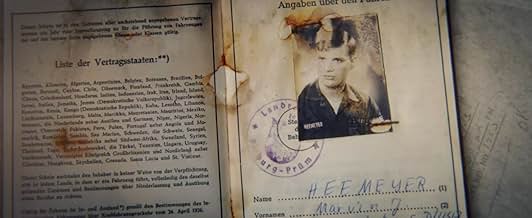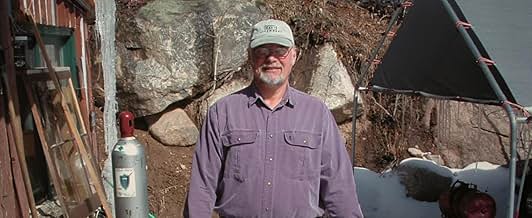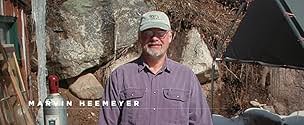Tread
- 2019
- 1h 29min
PUNTUACIÓN EN IMDb
7,1/10
3,7 mil
TU PUNTUACIÓN
Añade un argumento en tu idiomaPushed to his breaking point, a master welder in a small town at the foot of the Rocky Mountains quietly fortifies a bulldozer with 30 tons of concrete and steel and seeks to destroy those h... Leer todoPushed to his breaking point, a master welder in a small town at the foot of the Rocky Mountains quietly fortifies a bulldozer with 30 tons of concrete and steel and seeks to destroy those he believes have wronged him.Pushed to his breaking point, a master welder in a small town at the foot of the Rocky Mountains quietly fortifies a bulldozer with 30 tons of concrete and steel and seeks to destroy those he believes have wronged him.
- Premios
- 1 nominación en total
Marvin Heemeyer
- Self
- (metraje de archivo)
Glenn Trainor Jr.
- Self - Grand County Undersheriff 1993 - 2004
- (as Glenn Trainor)
Cody Docheff
- Self - Owner, Mountain Park Concrete
- (metraje de archivo)
Dick Thompson
- Self - Former Mayor of Granby, CO.
- (metraje de archivo)
Ron Thompson
- Self - Vice President, Sewer District Board
- (metraje de archivo)
Argumento
¿Sabías que...?
- CuriosidadesMarvin Heemeyer posthumously attained the nickname "Killdozer" due to his rampage.
- ConexionesReferenced in The Cinema Snob: Thunder Warrior (2022)
Reseña destacada
Greetings again from the darkness. If not so tragic, this story might fit best in Ripley's Believe it or Not. What better description is there for a small town welder who builds an armored bulldozer, weaponizes it, and then takes it on a rampage of revenge, destroying the buildings, homes, and businesses of those he believe 'wronged' him? This actually happened in Granby, Colorado in 2004, and that welder's name was Marv Heemeyer.
Filmmaker Paul Solet begins the film with a recording of a 911 call and news clips of the actual events of June 4, 2004. Solet then proceeds to lay out the backstory of Heemeyer, and how things escalated to the point where destruction and suicide seemed like the only logical step to him. Solet cleverly utilizes Heemeyer's own self-recording (via audio cassette) as a framing structure for the film. Heemeyer's voice tells us what his plan was, and why he had reached this level of desperation.
Interviews are key, and we hear from law enforcement officers who were on the scene that day, Heemeyer's ex-girlfriend Trisha MacDonald, his best friend, a younger man from his snowmobile club, brothers from a family that had supposedly targeted Marv, and a newspaper reporter, Patrick Brower, who also wrote a book on Heemeyer's rampage. Actual news clips and reenactments are used to show us what those being interviewed tell. In this case, it's an effective approach.
It's particularly interesting to hear that Marv was mostly a likable guy who just bumped up against local town and county politics a couple of times. Marv was not part of the 'good old boys club' and admits to needing to "teach a lesson" to those he perceived has gone out of the way to make life difficult for him. His bulldozer was a way for him to dole out the justice that was otherwise going unserved.
This is a story of revenge told in a somewhat sympathetic manner towards Marv Heemeyer, a man who considered himself "an American Patriot." The audio tape is clearly a confession of what he planned (and later carried out), and it was clear he knew this was a suicide mission. Listening to his rants, we assume some form of mental illness was involved, and his best friend describes him as a man who 'spent too much time alone."
The video clips of the carnage, and of the many law enforcement officials on the scene - all of whom were helpless to stop the bulldozer - are captivating and difficult to watch. Fortunately, after the fact, we know that no one died that day other than the man who was responsible. Marv, a man of "righteous anger", had his day of serving justice and rare 'Bulldozer Rampage' headline knocked off the front page one day later by a much bigger story.
Filmmaker Paul Solet begins the film with a recording of a 911 call and news clips of the actual events of June 4, 2004. Solet then proceeds to lay out the backstory of Heemeyer, and how things escalated to the point where destruction and suicide seemed like the only logical step to him. Solet cleverly utilizes Heemeyer's own self-recording (via audio cassette) as a framing structure for the film. Heemeyer's voice tells us what his plan was, and why he had reached this level of desperation.
Interviews are key, and we hear from law enforcement officers who were on the scene that day, Heemeyer's ex-girlfriend Trisha MacDonald, his best friend, a younger man from his snowmobile club, brothers from a family that had supposedly targeted Marv, and a newspaper reporter, Patrick Brower, who also wrote a book on Heemeyer's rampage. Actual news clips and reenactments are used to show us what those being interviewed tell. In this case, it's an effective approach.
It's particularly interesting to hear that Marv was mostly a likable guy who just bumped up against local town and county politics a couple of times. Marv was not part of the 'good old boys club' and admits to needing to "teach a lesson" to those he perceived has gone out of the way to make life difficult for him. His bulldozer was a way for him to dole out the justice that was otherwise going unserved.
This is a story of revenge told in a somewhat sympathetic manner towards Marv Heemeyer, a man who considered himself "an American Patriot." The audio tape is clearly a confession of what he planned (and later carried out), and it was clear he knew this was a suicide mission. Listening to his rants, we assume some form of mental illness was involved, and his best friend describes him as a man who 'spent too much time alone."
The video clips of the carnage, and of the many law enforcement officials on the scene - all of whom were helpless to stop the bulldozer - are captivating and difficult to watch. Fortunately, after the fact, we know that no one died that day other than the man who was responsible. Marv, a man of "righteous anger", had his day of serving justice and rare 'Bulldozer Rampage' headline knocked off the front page one day later by a much bigger story.
- ferguson-6
- 26 feb 2020
- Enlace permanente
Selecciones populares
Inicia sesión para calificar y añadir a tu lista para recibir recomendaciones personalizadas
- How long is Tread?Con tecnología de Alexa
Detalles
Taquilla
- Recaudación en Estados Unidos y Canadá
- 36.527 US$
- Fin de semana de estreno en EE. UU. y Canadá
- 10.585 US$
- 23 feb 2020
- Recaudación en todo el mundo
- 36.527 US$
- Duración1 hora 29 minutos
- Color
Contribuir a esta página
Sugerir un cambio o añadir el contenido que falta

Principal laguna de datos
By what name was Tread (2019) officially released in India in English?
Responde

![Trailer [EN]](https://m.media-amazon.com/images/M/MV5BYmVkZTY0MmEtNzBiZi00NWI5LWJjOGEtZjhlMjhhZGI2MmQ5XkEyXkFqcGdeQXRyYW5zY29kZS13b3JrZmxvdw@@._V1_QL75_UX500_CR0)
































